Those who were active marketers prior to the Internet can better appreciate what Internet Advertising has done for the industry. Before the Internet, marketers did the best they could to target the right audience at the right time, but not always successfully. For example, if they vaguely believed a potential client listened to a radio station at certain hours, then they ran their ad during that hour. When Dyson ran a TV ad for vacuum cleaners at 9 PM, they had no specific data on who could be a potential buyer. They simply hoped that the power of their persuasive TV ad could convince many to buy a new Dyson vacuum. We call this Extrinsic Motivation advertising. The TV ad for Dyson did all it could to extrinsically motivate you to buy their vacuum cleaner. I know the word extrinsic is kind of vague, but I will soon make it clear.
Before the Internet, the only way advertisers could reach a true potential client was through Yellow Pages or a similar medium (like mail order). If you opened the Yellow Pages to search for a plumber, you were intrinsically motivated. There was no external persuasion (such as a TV or radio ad) that enticed you to call a plumber. Instead, your pipe broke and hence you needed a plumber. This was a pure intrinsically motivated search for a plumber. The Yellow Pages, however, had limitations. It was very local. But it definitely did a great job. Everyone in 70’s, 80’s and 90’s had to have Yellow Pages. You could not live without it. Trust me on this. I am old enough to know.
Things dramatically changed after the introduction of the Internet. If a person used Google or Bing to find a product, he or she was mostly intrinsically motivated, just as if you opened the Yellow Pages. However, Google was not just local. You can now buy the best quality of anything from Amazon, or a store in New York, Canada, Miami, or Seattle…
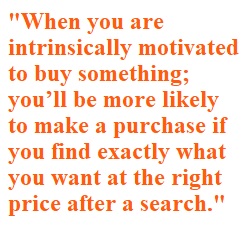 I’d like to emphasize again the difference between intrinsic and extrinsic motivation advertising. When you are intrinsically motivated to buy something; you’ll be more likely to make a purchase if you find exactly what you want at the right price after a search. The psychology is different from when you are sitting in front of TV and see a Dyson TV ad (extrinsic advertising). If you have a new vacuum cleaner in your closet, you might not have any motivation to buy a Dyson. Hence, imagine if all the TV viewers on a certain night have brand new vacuum cleaners (hypothetically). What happens to the Dyson ad? It is a total waste of their money. This isn’t just a hypothetical scenario; it’s a real issue. This is the major limitation of extrinsic motivated advertising, but with Pay Per Click advertising, this scenario will never happen. It is absolutely impossible!
I’d like to emphasize again the difference between intrinsic and extrinsic motivation advertising. When you are intrinsically motivated to buy something; you’ll be more likely to make a purchase if you find exactly what you want at the right price after a search. The psychology is different from when you are sitting in front of TV and see a Dyson TV ad (extrinsic advertising). If you have a new vacuum cleaner in your closet, you might not have any motivation to buy a Dyson. Hence, imagine if all the TV viewers on a certain night have brand new vacuum cleaners (hypothetically). What happens to the Dyson ad? It is a total waste of their money. This isn’t just a hypothetical scenario; it’s a real issue. This is the major limitation of extrinsic motivated advertising, but with Pay Per Click advertising, this scenario will never happen. It is absolutely impossible!
Just like the Yellow Pages before them, Internet search engines help facilitate Intrinsic Motivated advertising. However, this type of advertising is much more effective since it is highly interactive and not just local. It’s also important to examine the statistical difference between the two. If 10 people are intrinsically motivated to buy your product through your website, the statistic law of intrinsic motivated advertising dictates that you must sell at least to 1 visitor. This means your conversion rate must be better than 10 percent and that is what we strive for if we design your website or landing page. This law assumes you have a 100 percent optimized website or landing page.
For Dyson TV advertising, the law of extrinsic motivated advertising applies and dictates that Dyson needs an estimated 500 to 1000 people to watch their ad to sell just one Dyson vacuum cleaner. Obviously, 1 out of 10 is more powerful than 1 out of 500 or 1000. That’s why almost everyone believes in the power of Internet advertising. You’ll spend less money and you’ll reach the most potential buyers immediately. Most advertisers on the Internet know this fact based on their past PPC experiences, even though they have no knowledge of intrinsic and extrinsic motivation psychology to make their website and/or landing pages optimized and get closer to 10 percent conversion rate. Some are very lucky that their landing pages are somewhat optimized and convert, not at 10 percent, but perhaps at 1 or 2 percent. But since the PPC cost is low, even at a 1 or 2 percent conversion rate they make tons of money. The image below shows why.
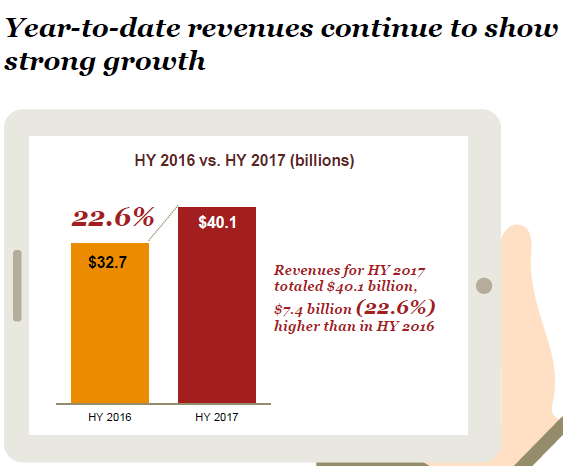
Source: IAB internet advertising revenue report – 2017 first six months results
Now that we’ve piqued your interest on Internet Advertising, let’s see how Internet Advertising actually works.
The most effective avenues for Internet Advertising are through either Google or Bing advertising, which are typically called Pay Per Click (or PPC) advertising. These services are called Pay Per Click because you will pay Google or Bing for each click on your ad. This can range from a few dollars to even above 100 Dollars (such as keywords for “Injury Attorneys,” who often have fierce bidding competition).
The Internet advertising cost per click is based on bidding to determine which advertiser should be placed on top in the search results page. Google usually shows only 4 advertisers on top of search results. The advertiser who bids highest usually ends up at the top. Google and Bing provide you with all the data you need to figure out how you can bid effectively. They also have a measuring concept called Quality Score which can multiply your bid higher if you write a better ad and create a more relevant landing page. What does this mean? This means if you have a better ad and better landing page than your competition, you can bid lower and still have your ad placed on top. A good PPC management company can do this for you very effectively, which ultimately means you’ll pay less for the clicks.
Here are the main steps to create a PPC campaign:
- You write a three line ad with your keywords in the ad for relevancy and maximizing the Quality Score.
- You select all the relevant keywords for your product.
- You set a geographic area you want to show your ad (Beverly Hills, San Diego…).
- You select a schedule and the time you want to run your ad.
- You choose a bidding strategy so you compete very effectively and always on top of the results page.
To reduce the irrelevancy of clicks you will also give Google or Bing all the Negative Keywords you can think of. For example, if your name is Dr. Ryan, you don’t want someone who is searching for Dr. Jim to see your ads and by mistake click on it. So, Dr. Jim will be the Negative keyword for Dr. Ryan PPC campaign. A good PPC management company will do this for you. For example, at Goldman Marketing Group, we search through Yelp for all the competition in your area and adds these names as negative keywords.
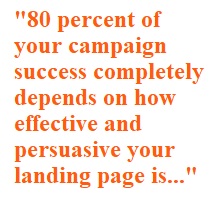 Next, you will start getting quality clicks when the right people search for your keywords, which happens immediately after your advertising campaign is approved by Google or Bing. Notice that Quality, the Right audience, Keywords, and Immediacy are the main pillars of Internet Advertising. However, the important truth is that PPC campaign creation and management (that was described in the 6 steps above) is only accountable for 20 percent of a campaign’s success. The rest really depends on the effectiveness of your landing page. Yes, 80 percent of your campaign success completely depends on how effective and persuasive your landing page is in terms of the Psychology of Intrinsic Motivation Advertising as we analyzed above.
Next, you will start getting quality clicks when the right people search for your keywords, which happens immediately after your advertising campaign is approved by Google or Bing. Notice that Quality, the Right audience, Keywords, and Immediacy are the main pillars of Internet Advertising. However, the important truth is that PPC campaign creation and management (that was described in the 6 steps above) is only accountable for 20 percent of a campaign’s success. The rest really depends on the effectiveness of your landing page. Yes, 80 percent of your campaign success completely depends on how effective and persuasive your landing page is in terms of the Psychology of Intrinsic Motivation Advertising as we analyzed above.
Since the majority of people who have landed on your page are intrinsically motivated, the marketing strategy changes dramatically compared to the old classical marketing strategies taught in text books. Through your landing page or website, you must now foster their intrinsic motivation. This is the art of professional design combined with astute marketing.
Allow me to give you a very interesting example. Let’s assume that your electricity bill has skyrocketed ever since your college-educated son has moved back home after finishing school (creating intrinsic motivation for you to lower your electricity bill). You are debating with your significant other on whether you should get solar panels. This decision is purely intrinsically motivated, and you will probably start your search on Google or Bing. Let’s also assume that you found these two websites as potential solar providers:
1) https://us.sunpower.com/landing/solar-planet/
2) http://www.codegreensolar.com/speak-to-a-solar-expert-lp
Which one do you select? You will select the one that most closely fosters your intrinsic motivations for saving on your electric bill. Right? This is very simple. Yet, advertisers still make mistakes. One recent solar TV commercial actually said, “the installers are great roofers.” I am sure you get the idea. “Installers are great roofers” is absolutely extrinsic to your intrinsic motivation of saving on your electricity bill. If any of these two websites could correctly predict complete visitor’s intrinsic motivations, it will be more successful.
Here at Goldman Marketing Group, we design effective landing pages and websites that foster your visitors’ intrinsic motivations. Hence we can achieve conversion rates better than 10 percent. In some case we have even achieved conversion rates at 50 and 60 percent. When we design a landing page, it must instill a sense that future is bright after purchasing your service or products. Each website has its own unique intrinsic motivation characteristics. For a hair transplant doctor, the landing page must instill the intrinsic idea that a hair transplant will bring success in profession, social and class status…and perhaps even more fulfilling relationships. Here are the intrinsic motivations for a hair transplant candidate:
1) How complicated is the surgery?
2) What is the process of Hair Transplant?
3) Is this my own hair?
4) Can I color it?
5) Can I get a regular hair cut?
6) Can I wash regularly?
7) Can I swim with it? How long will it stay on my scalp?
8) How much is it per hair graft?
9) Are they in touch with my attitude, my current general mood, and my perception of social reality?
10) Some of the candidates for hair transplants are transgender. This is their social reality. Being sensitive to their needs and also fostering their intrinsic motivations are vital.
In summary, the success of any website or landing page depends on several main intrinsic motivational rules.
1) Does the website get me?
2) Does it understand what the visitor wants?
3) Does it create trust?
4) Does it create credibility?
5) Does it address and foster the intrinsic motivation of the visitor?
6) Does it let the visitor imagine or get the feeling that the future is bright after they buy your service or the product?
7) Does it remove the obstacles to buy your service or products?
8) Is your website or landing page persuasive?
Other Advantages of PPC Advertising
With PPC, you have full control over who should see your ad. You can measure or cap how much you have spent instantly. You can set limits on cost per clicks. You can get data on how far the visitor was from your company when he clicked on your ad. What hours of day did he click on your ad? What day did he click on your ad? Did he actually convert or buy? Did he see your video on your website? Google and other third-party companies such as SpyFu and Ahrefs provide you with all the data you need about your competition and their keywords.
You can increase the bids on a certain geographic area so that you get more conversion. You can increase the bids for certain days or hours when you have more conversions. You can give addresses of hospitals to Google so your ad shows up only when people are near those hospitals in case you are an injury attorney. You can give the address of every movie theater if you are advertising for your next movie…
Google has shown that people usually don’t make their decision on their first visit to your website. They may visit your Facebook, RealSelf, Instagram, or Pinterest pages before coming back to your website, after which they might finally make a purchase. You can track them through channels using Google Analytics. It is unbelievable how much data Google provides so you can make the right decision and/or even lower your cost effectively. It is the job of a PPC management company to rummage through the data to dig essential concepts that were hidden. We make your phone ring!
Goldman Marketing Group has achieved better than 10 percent conversion rates for most of our clients. We monitor your campaign daily to better understand your website visitors, their intrinsic motivations, or even find more relevant keywords that we were not aware at the start of your campaign.
Here are some interesting Goldman achievements. We have an example of a Dermatologist in Nashville, a Skin Cancer Center in Nashville, and a Rhinoplasty Center in New York.
Skincare and Dermatologist:
Only 12 calls in Early November before we took over!
We started optimizing on November 15th.
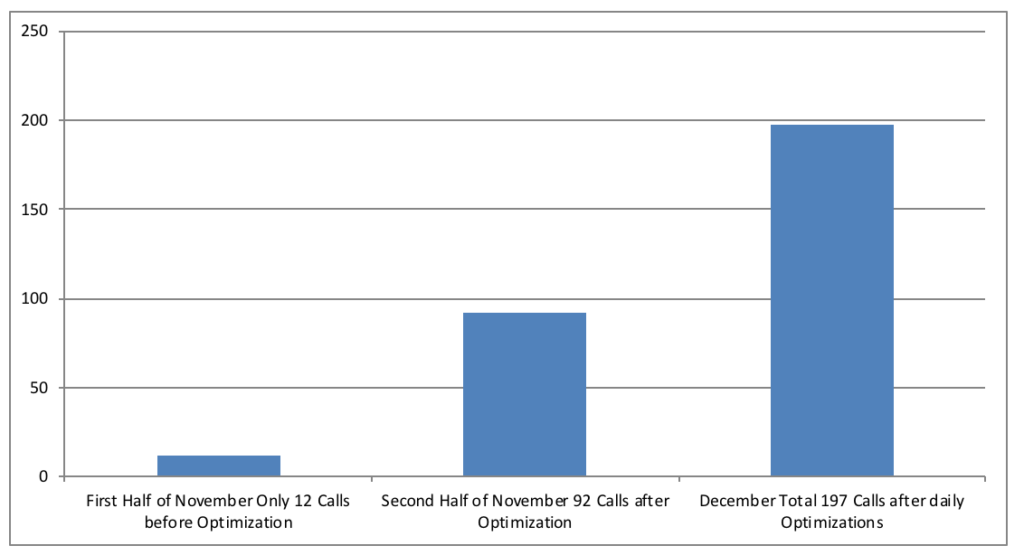
Skin Cancer Center in Nashville:
Only 2 skin cancer calls up to December 14th. 21 calls after we started optimizing.

Another Example: Rhinoplasty Center in New York:
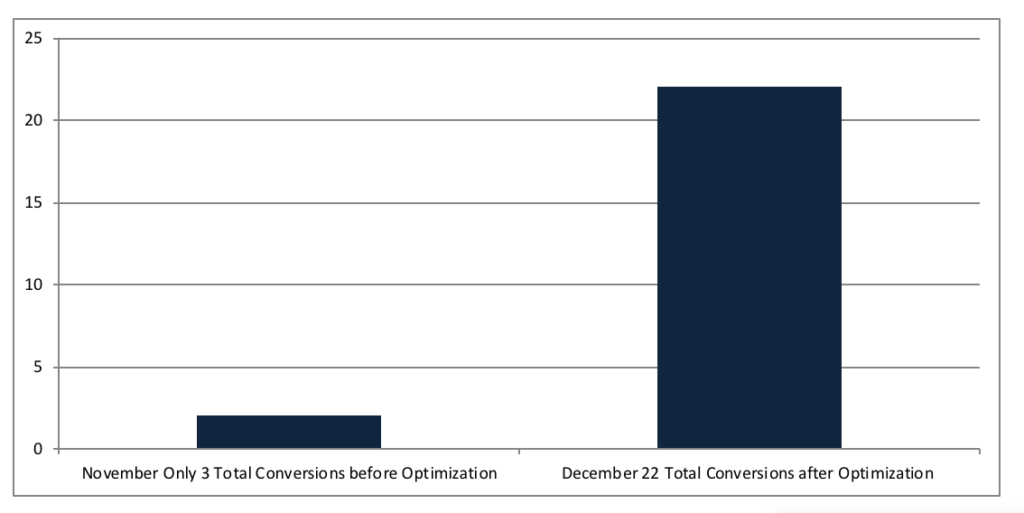
Goldman Marketing Group creates ads and AdWords campaign with better than 10 percent conversion rates. Here are some examples:
Conversion Rate for one of our Nashville Dermatologists 60 percent

Conversion Rate Skin Center Better than 37 percent

Conversion Rate for Nashville Skin Cancer Better than 32 percent

Conversion Rate for Nashville Dermatologist better than 27 percent

